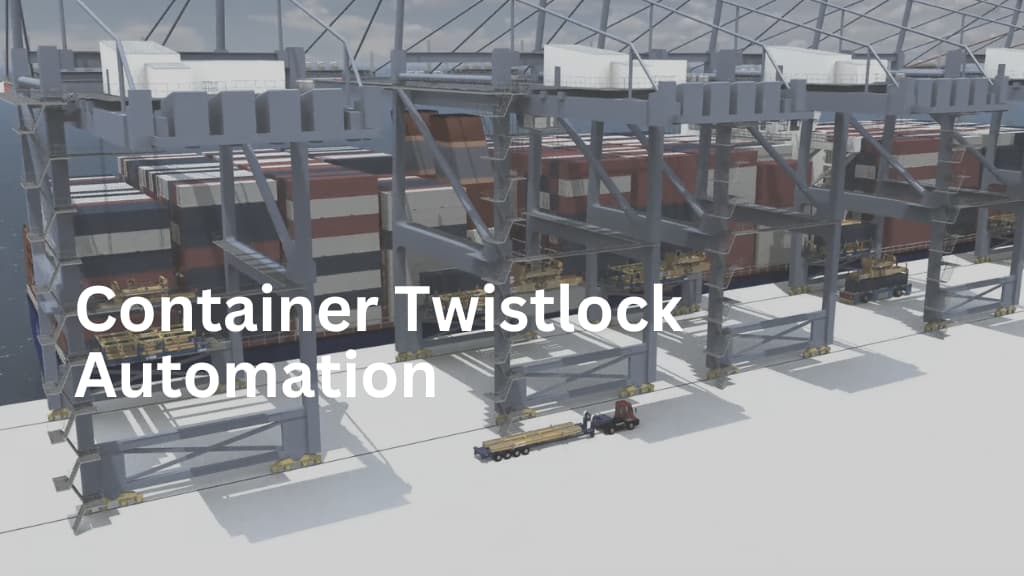Port automation is a rapidly growing trend in the shipping industry as ports look to improve efficiency and safety in container handling operations. One area that has seen slower adoption of automation is the removal and replacement of container twistlocks. Twistlock handling is considered the most dangerous job in the container handling process, yet it is the only area terminals are not adopting automation.
Introducing twistlock automation
RAM Spreaders has developed the PinSmart machine, a fully autonomous solution for twistlock automation to address this. The machine comes in two forms: a quayside operation, where the container(s) are placed on a platform at the quayside, or a drive-through operation, where a vehicle carrying the container drives through a column of PinSmart machines at the wharf. The PinSmart’s robotic arm can remove or replace all ISO twistlock types in 10 seconds and can handle 20ft/40ft/45ft container sizes and multiple containers at once. Specifically, the PinSmart machine for quayside operations can handle 1 x 20ft/40ft/45ft, 2 x 20ft/40ft/45ft or 4 x 20ft ISO containers.
What is a twistlock?
A twistlock is a securing device to physically connect and secure stacked containers onboard the shipping vessel. Generally speaking, twistlocks are removed or inserted into the corner casting of containers by stevedores during loading or unloading operations. Three types of twistlocks can be distinguished:
-
-
- Manual twistlocks – which must be manually unlocked
- Semi-automatic twistlocks – which lock automatically when the container is set down on the ship but unlocked manually before unloading.
- Fully–automatic twistlocks are automatically locked by the container’s weight and unlocked by the crane’s lifting force.
-
How are twistlocks removed and replaced?
PinSmart’s robotic arm can remove or replace all ISO twistlock types in as little as 10 seconds due to the cleverly designed end manipulator and the machine’s ability to know which twistlock is being removed or replaced. The capability to know which twistlock is being placed or removed is based on the machine integrating with TOS systems that hold the ship’s container data.
Improving efficiency
Automating twistlock handling will improve the efficiency and safety of quayside container operations and free up port staff to be utilized in other areas where support is needed. Container terminals with a regular flow of containers to be handled at the quayside are the ideal candidates for this technology.
In all weather conditions, the PinSmart machine is designed to perform efficiently and is a reliable solution for closing the automation link between the quayside and the container yard.
How will quayside safety improve?
Let’s address the elephant in the room. Twistlocks are traditionally handled by stevedores, often 2 or 4 per crane depending on the urgency or priority of the vessel. With PinSmart, twistlocks will be removed autonomously from each container’s corner castings. As port staff are not used to handling the twistlocks, it allows staff to be utilized in other areas of the port where support is needed. But, most importantly, staff are in no danger.
How will costs improve?
However, it’s not just about the safety and efficiency benefits of port automation; it’s also about the cost savings and the ability to handle a growing freight volume. With port automation systems, such as PinSmart, terminals can handle more cargo efficiently and help reduce damage to containers, cargo and equipment, leading to fewer claims and lower insurance costs.
Stay ahead of the curve
Another advantage of port automation is handling a growing volume of freight. As global trade continues to expand, ports face the challenge of handling an increasing number of containers. Automation can help ports meet this challenge by allowing them to handle more containers with the same amount of equipment and staff. This is particularly important for ports operating at or near capacity, enabling them to handle more cargo without investing in expensive new infrastructure.
Faster Turnaround
Furthermore, it’s not just the ports that benefit from automation; shippers and carriers also stand to benefit. Automation reduces the time containers spend in the terminal, allowing them to be loaded and unloaded more quickly. This means that shippers can get their goods to market faster, and carriers can move on to their next port of call sooner.
Conclusion
In conclusion, port automation is a key trend in the shipping industry and brings many benefits. Automating the removal and replacement of container twistlocks, such as the PinSmart machine, will improve the efficiency and safety of quayside container operations. It’s a cost-effective solution that allows terminals to handle more cargo with fewer staff, reduces the risk of damage to containers, cargo, and equipment, and helps ports handle an increasing number of containers. Automation also benefits shippers and carriers by reducing the time containers spend in the terminal, allowing them to be loaded and unloaded more quickly. With the use of port automation systems, ports can handle more cargo more efficiently and safely.
Learn more about PinSmart
Frequently Asked Questions
How does PinSmart integrate with TOS systems?
PinSmart can integrate with TOS systems that hold the ship’s container data. This allows the machine to know which twistlock is being removed or replaced and to communicate with the crane and the platform.
How does PinSmart handle different weather conditions?
It has a robust and weatherproof structure and a self-cleaning mechanism to prevent dust and debris from affecting its performance.
What are the benefits of twistlock automation?
Twistlock automation can improve the efficiency and safety of quayside container operations by reducing the manual labour and risk involved in twistlock handling. It can also free up port staff to be utilized in other areas where support is needed.

